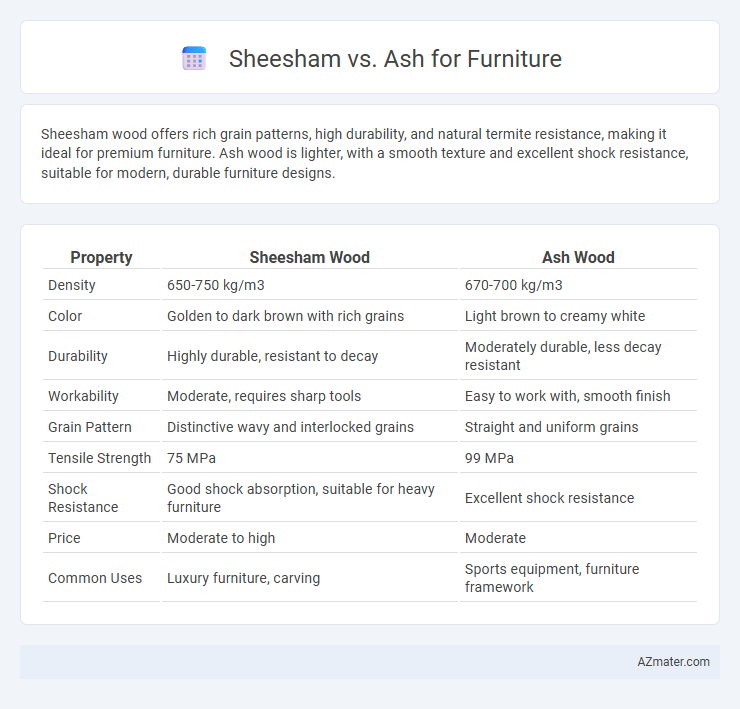Sheesham wood offers rich grain patterns, high durability, and natural termite resistance, making it ideal for premium furniture. Ash wood is lighter, with a smooth texture and excellent shock resistance, suitable for modern, durable furniture designs.
Table of Comparison
| Property | Sheesham Wood | Ash Wood |
|---|---|---|
| Density | 650-750 kg/m3 | 670-700 kg/m3 |
| Color | Golden to dark brown with rich grains | Light brown to creamy white |
| Durability | Highly durable, resistant to decay | Moderately durable, less decay resistant |
| Workability | Moderate, requires sharp tools | Easy to work with, smooth finish |
| Grain Pattern | Distinctive wavy and interlocked grains | Straight and uniform grains |
| Tensile Strength | 75 MPa | 99 MPa |
| Shock Resistance | Good shock absorption, suitable for heavy furniture | Excellent shock resistance |
| Price | Moderate to high | Moderate |
| Common Uses | Luxury furniture, carving | Sports equipment, furniture framework |
Introduction to Sheesham and Ash Wood
Sheesham, also known as Indian rosewood, is a hardwood prized for its rich, dark grain patterns and natural luster, offering excellent durability and resistance to termites, making it ideal for fine furniture. Ash wood is lighter in color with a straight grain, known for its exceptional strength, flexibility, and shock resistance, often used in both traditional and modern furniture designs. Both woods offer distinct aesthetic and structural qualities, but Sheesham's density and unique grain make it a preferred choice for ornate or intricate furniture pieces.
Key Characteristics of Sheesham Wood
Sheesham wood, also known as Indian rosewood, is prized for its rich, dark brown color with distinctive grain patterns, making it a popular choice for high-end furniture. It exhibits excellent durability, resistance to decay, and natural oils that protect against pests, ensuring long-lasting furniture pieces. Compared to Ash, Sheesham has a denser, harder texture and superior resistance to moisture, making it ideal for both indoor and outdoor applications.
Key Characteristics of Ash Wood
Ash wood is lightweight yet exceptionally strong, making it ideal for durable furniture pieces with high impact resistance. Its distinct straight grain and pale cream color enhance aesthetic appeal while allowing for smooth finishes and easy staining. Ash also offers excellent flexibility and shock absorption, qualities highly valued in furniture requiring both strength and comfort.
Durability and Strength Comparison
Sheesham wood, known for its dense grain and natural oils, offers superior durability and resistance to wear, making it ideal for long-lasting furniture. Ash wood, while slightly lighter, provides excellent strength and flexibility, ensuring sturdy construction and shock resistance in furniture pieces. Both woods excel in durability, but Sheesham's natural insect-repellent properties give it an edge in longevity compared to Ash.
Aesthetic Differences: Grain and Color
Sheesham wood exhibits a rich, dark brown hue with deep reddish tones and a striking, intricate grain pattern that enhances furniture aesthetics. Ash wood features a lighter, creamy to pale beige color with a straight, uniform grain that provides a sleek, modern look. The contrasting grain texture and color between Sheesham and Ash make them ideal for different design preferences, with Sheesham offering a more traditional, rustic feel, while Ash suits minimalist, contemporary styles.
Suitability for Furniture Types
Sheesham wood, known for its rich grain and durability, is highly suitable for ornate furniture like cabinets, tables, and decorative pieces due to its natural resistance to pests and moisture. Ash, characterized by its light color and strong, flexible fibers, excels in crafting furniture requiring shock resistance and bending qualities, such as chairs, rocking chairs, and sports equipment. Both woods offer distinct advantages, with Sheesham favored for heavy-duty, artistic furniture and Ash preferred for lightweight, functional designs.
Maintenance and Care Requirements
Sheesham wood requires moderate maintenance, benefiting from regular oiling to enhance its natural grain and prevent drying or cracking, while Ash demands less frequent treatment but still needs occasional polishing to maintain its light color and smooth texture. Both woods should be protected from excessive moisture and direct sunlight to avoid warping or discoloration, with Sheesham being more resistant to termite attacks due to its dense grain. Proper dusting and avoiding harsh cleaners extend the lifespan of furniture made from either wood, ensuring longevity and aesthetic appeal.
Price and Availability
Sheesham wood typically costs more than Ash due to its dense grain and durability, making it a premium choice for high-end furniture. Ash is more readily available and affordable, favored for its light color and excellent shock resistance, which suits budget-conscious projects. The widespread sourcing of Ash ensures steady supply, whereas Sheesham's limited geographic growth regions can affect availability and pricing fluctuations.
Environmental Impact and Sustainability
Sheesham wood, sourced primarily from the Dalbergia tree, is known for its durability and naturally resistant oils, making it a sustainable choice when harvested from well-managed plantations. Ash wood, native to North America and Europe, is rapidly renewable due to its fast growth rate, supporting reforestation efforts and carbon sequestration. Both woods provide eco-friendly options for furniture, but Sheesham's slower growth requires careful management to avoid deforestation, while Ash offers a lower environmental impact through quicker regeneration cycles.
Which Wood Is Best for Your Furniture Needs?
Sheesham, also known as Indian Rosewood, offers rich grain patterns and natural durability, making it ideal for ornate furniture and long-lasting pieces. Ash wood provides a lighter color with a straight grain, known for its strength, flexibility, and shock resistance, which suits modern and functional furniture designs. Choosing between Sheesham and Ash depends on the desired aesthetic, durability requirements, and the specific use of the furniture in your home.

Infographic: Sheesham vs Ash for Furniture
 azmater.com
azmater.com